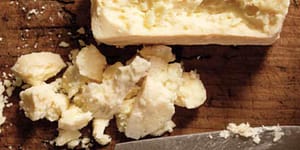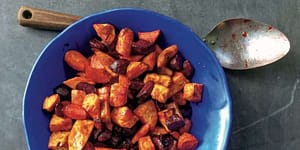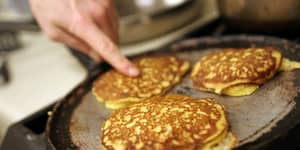The Whole Sunflower: Delicious Down to the Stem

“The process of cooking sunflowers is slightly different from that for cooking artichokes, with the result being a unique vegetable with the texture of an artichoke and a strong sunflower flavor.”— Alan Bergo
Did you know that more than just the seeds of a sunflower are edible? Almost every part of this tall, beautiful plant is completely safe (and delicious) to eat when cooked and combined with the right ingredients.
The following is an excerpt from The Forager Chef’s Book of Flora by Alan Bergo. It has been adapted for the web.
 The Sensational Sunflower
The Sensational Sunflower
Sunflowers are more than a seed crop. Drive down country roads in the summer where I live, and you’ll see giant sunflowers towering over gardens, telling you summer is at its peak. If you look at the plants while they’re growing, at the stage before the flowers bloom you might notice that they resemble an artichoke, and you’d be right.
Sunflower vs. Artichoke
An artichoke, is, after all, just an unopened flower caught at the right stage. The process of cooking sunflowers is slightly different from that for cooking artichokes, with the result being a unique vegetable with the texture of an artichoke and a strong sunflower flavor.
There are a few chefs who know this trick. I learned it by watching Daniel Humm of Eleven Madison Park, but I was also reminded of it by my friend Sean Sherman, who says there was a long history of Indigenous use of sunflower heads. He describes a method for cooking them in his book, The Sioux Chef’s Indigenous Kitchen.
Edible Parts of A Sunflower
In addition to their unripe flowers, sunflowers have other edible parts most chefs I know rarely think to use. The leaves, although a bit too intensely flavored to serve as cooked greens, are great blanched and used for things like Roulades Verts or wrapping a delicate fish such as a walleye before it hits the grill.
At the same time you cut the unripe flower, the top 6 to 12 inches (15–30 cm) of the stem can be tender and delicious, peeled and cooked into what I would call sunflower marrow, in a nod to Chef Dan Barber who does the same with kale, broccoli, and cauliflower stems.
Sunflower Growth Season
If you miss the period of growth for sunflower artichokes, the seeds that form afterward, still white and immature, are tender, mild, and delicious in soups, in risotti, as a sprinkle, or tossed into pilafs. Finally, the tubers or sunchokes / Jerusalem artichokes, although from a cousin plant, are delicious and have a beautiful, otherworldly shape. Harvesting them is like digging for buried treasure in the fall.
RECIPE: Sunflower Artichokes
Serves 2 as an appetizer

Ingredients
- 1 large green sunflower
- 5 cups (1.25 L) unsalted water or vegetable stock, divided
- Kosher salt, to taste
- Olive or Smude’s sunflower oil, for serving (optional)
Procedure
Bring 4 cups (945 ml) of the water to a simmer in a tall saucepot, then cook the sunflower head for 3 to 4 minutes. Remove the sunflower from the pot, then transfer it to a sauté pan with the remaining water and a good pinch of salt. Cover the pan, then simmer, turning occasionally, until the sunflower bud is tender when pierced with a knife, about 3 to 4 minutes, depending on size.
Make sure the buds are tender, as you won’t be able to clean them properly otherwise. Allow the sunflower to cool, then transfer it to a cutting board and trim with a paring knife, first removing the outer leaves, then scraping out any flower petals from the inner portion of the bud, just as you would with an artichoke.
Do not remove the base of the stem. It’s delicious—almost the best part of the plant, just like an artichoke. If you won’t be using the buds immediately, transfer them to a lidded container and refrigerate until needed. I like to serve them cut into pieces, warmed, drizzled with Smude’s oil and lemon, and crowned with a sprinkle of sunflower seeds.
Recommended Reads
Recent Articles
If you read our post about growing koji in your kitchen, you’re probably itching to try out those new koji skills! This miso cheese recipe is an excellent next stop on your koji-kitchen journey. Miso cheese is sure to add a twist to any cheese lover’s plate, plus it’s easy to make at home! The following…
Read MoreDo you still have an abundance of root veggies from your final fall harvest? You’re in luck! This pomegranate drizzle will add just the right amount of “oomph” to your favorite dish of roasted root veggies. The following recipe is from The Fruit Forager’s Companion by Sara Bir. It has been adapted for the web. RECIPE:…
Read MoreGrains are a ubiquitous part of the American diet and a staple in many of our favorite recipes. Bread? Yep, grains. Pasta? Grains there, too. Pancakes? Most definitely! With such a strong presence in our daily eating habits, shouldn’t we know more about what grains actually are and why they make our favorite foods taste…
Read MoreTurn any night into pizza night! This sourdough pizza holds the secret to a stress-free weeknight dinner. Make the crust ahead of time and let it rise in the fridge. By dinnertime all you’ll need to do is shape the dough, add your toppings, and bake! This excerpt is from The Occidental Arts and Ecology…
Read MoreA sweet cornbread made with blue cornmeal draws on traditional Mexico and US Southwest flavors. The blue cornmeal gives its haunting flavor and lavender hue.
Read More









